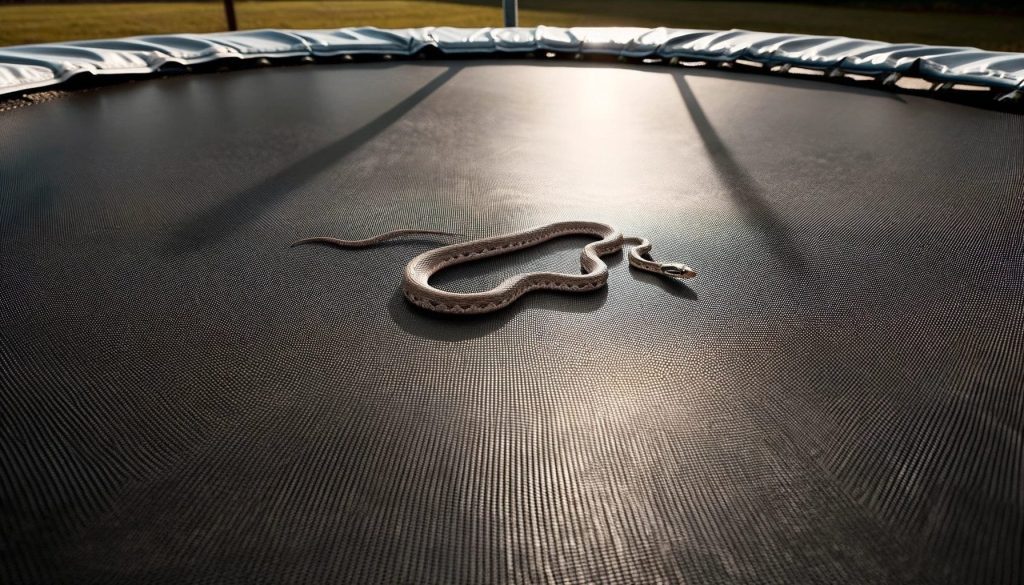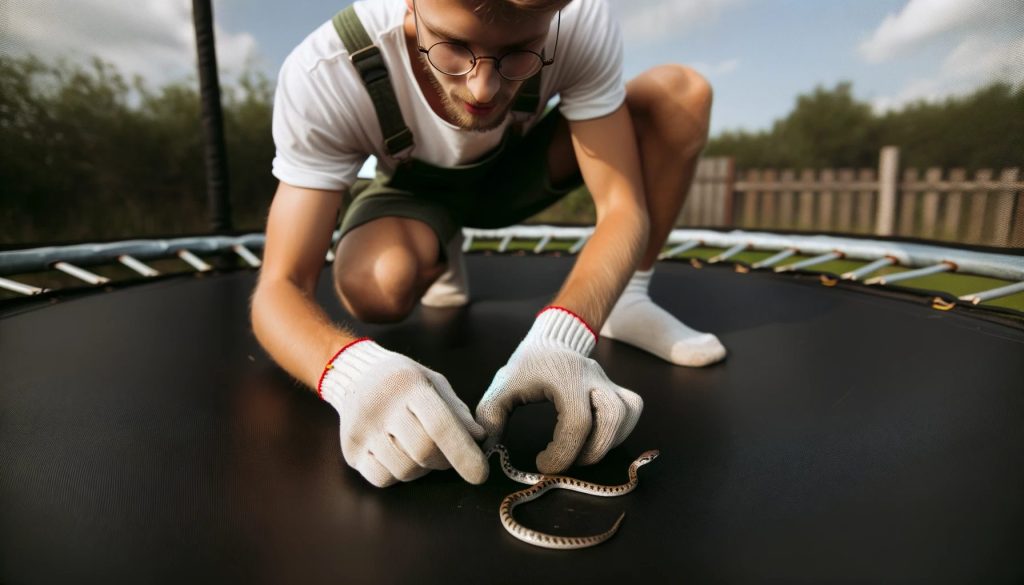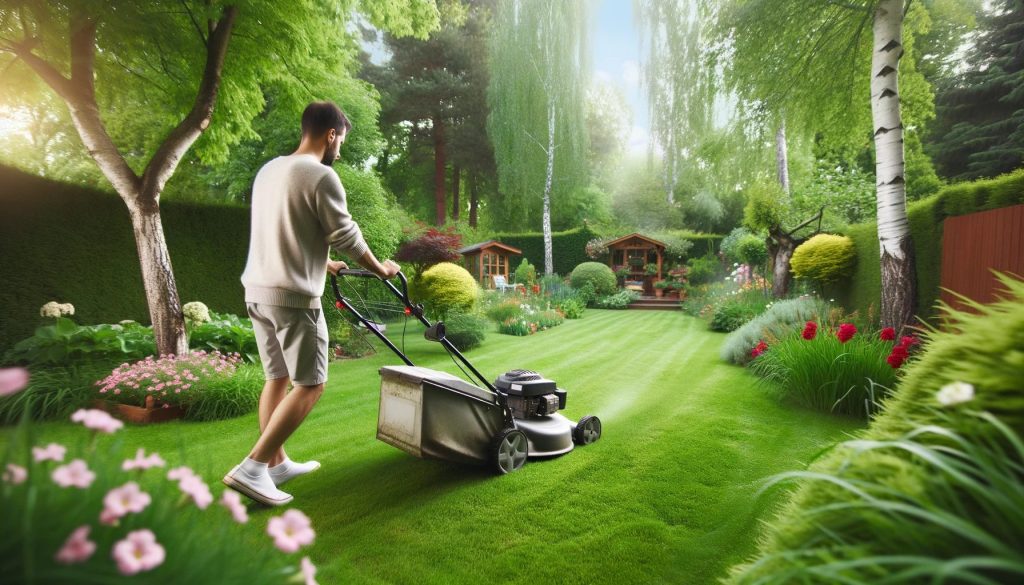Disclaimer: This post contains affiliate links. If you click and buy, we may make a commission at no additional charge to you. Please see our affiliate disclosure for more details.
In ground trampoline snakes is a very common thing. If you live in an area where there are venomous snakes such as copperheads or rattlesnakes, it is important to be aware of the potential danger they pose.
Many people are bitten each year while playing on ground trampolines, so before your kids (or you) take a tumble outdoors, check your yard for these slithering reptiles.
But how to get rid of in ground trampoline snakes?
To get rid of in-ground trampoline snakes, regularly inspect and remove potential hiding places like dense brush and debris. Block snake holes, eliminate their food sources, and maintain a clean yard. Consider using snake repellents, installing a snake-proof fence, and mowing your lawn frequently. If needed, call professionals for safe snake removal.
With a little bit of prevention, everyone can safely enjoy their backyard oasis – even if there’s a snake or two lurking about!
The Dangers of Having Snakes Around Trampoline

There are several dangers associated with having snakes under in ground trampoline.
First, if a snake should happen to coil itself around the legs or body of a user while they are jumping, it could easily cause the jumper to lose their balance and fall off the trampoline.
Secondly, if a snake should happen to strike at a user while they are jumping, the force of the strike could easily knock them off the trampoline.
Also, if a venomous snake should happen to bite a user while they are jumping, the venom could easily enter their system and cause serious health problems.
Which Backyard Snakes Can Be Deadly for You And How to identify them?
There are various types of snakes found in backyards across America. Some of these snakes are venomous and can be deadly if not handled properly. It is important to be able to identify these snakes so that you can take the necessary precautions when dealing with them.
Some of the more common backyard snakes that can be deadly include the copperhead, the cottonmouth, and the rattlesnake. These snakes are all venomous and can cause serious injury or even death if they are not handled properly.
If you encounter one of these snakes, it is important to stay calm and call for help immediately.
To identify a venomous snake, you should look for certain characteristics. Venomous snakes will usually have a triangular head, vertical pupils, and heat-sensing pits on their faces. They will also have fangs that are capable of injecting venom into their prey.
If you see any of these characteristics, it is important to keep your distance and call for help immediately.
Non-venomous snakes will usually have a round head, elliptical pupils, and no heat-sensing pits. They will also lack the fangs that are necessary for injecting venom.
If you see a snake with these characteristics, it is generally safe to approach it and try to capture it. However, you should always be careful about snakes.
Sometimes, some snakes might have some exceptions, and they might be venomous that you never even have thought of. So, it’s better not to mess with the snakes in the first place.
Spotting the Signs of Snakes in Your Yard
If you suspect snakes may be lurking in your yard, there are several tell-tale signs you can look for. Being able to identify these clues will let you know if snakes are present and take steps to remove them. Some things to be on the lookout for include:
Droppings: Snake feces are tubular shaped, sometimes with a white or chalky tip. They can resemble the droppings of birds or rodents but tend to be more elongated.
Tracks: Snakes leave noticeable trails in dirt, sand, or mud. The patterns look like curved or wavy lines from their slithering movement.
Holes: Snakes often occupy holes and burrows in yards, likely made by other animals like rodents. Keep an eye out for signs of activity around these holes.
Odors: A musky or foul odor coming from piles of debris or enclosed spaces may indicate a snake den in the area. This could be under porches, patios, or decks.
Rustling: If you hear rustling in bushes, shrubs, or dense vegetation this can signal a snake is hiding within. Snakes can move very stealthily.
Sightings: Actually seeing a snake, even briefly, means they are lurking nearby. Note any patterns, size, and coloring to help identify the species.
Evidence of Prey: If you notice small animal carcasses, chewed remains, or frequent rodent holes, snakes may be feeding on the available prey in your yard.
Staying vigilant in checking for any of these signs will let you know if snakes are on your property. Then you can take proactive removal measures to keep your yard safe and snake-free.
Letting snakes establish residence puts pets and kids at risk, so identify and address the issue as soon as these clues present themselves.
What to do if you see a snake on your trampoline?
Don’t panic
If you see a snake on your sunken trampoline, there’s no need to panic. Chances are, the snake is more scared of you than you are of it! Snakes are generally shy creatures that will avoid human contact if they can.
However, if the snake feels threatened or cornered, it may strike out in self-defense. That’s why it’s important to stay calm and not startle the snake.
Get the Snake Off the Trampoline

If it’s safe to do so, gently place a stick or pole behind the snake’s head, and guide it off the trampoline and into some nearby grass or bushes. If you can’t reach the snake safely, leave it be and call animal control for assistance.
Don’t Try to Kill the Snake
Killing a snake is not only unnecessary, and it’s also illegal in many states.
If you’re not comfortable having a snake on your property, the best thing to do is to just let it go on its way and ask for professional help.
Make snake Traps
Snake traps are simple methods that can be used to catch and remove snakes from your property. Building a snake trap is a great way to catch snakes. These traps can be purchased online or at your local hardware store.

Image: Snake Traps
Consider Calling a Professional to Remove it
If you’re still feeling uneasy about the situation, you can always call a professional snake removal service to come and take care of the problem for you. They will have the experience and knowledge to safely remove the snake from your property and relocate it to a more suitable habitat.
This is a great way to get rid of snakes, especially when you have larger snakes around your trampoline.
Prevention tips to keep Snakes away from your property
1. Remove potential hiding places
One of the best ways to keep snakes away from your property is to remove potential hiding places. Snakes like to hide in dark, cool places, so removing areas where they can do this will make your property less attractive to them.
Some potential hiding places include:
- Dense brush
- Piles of leaves or other debris
- Holes in walls or foundations
- Under porches or decks
These are just a few examples, so take a look around your property and see if there are any other potential hiding places that you can eliminate.
2. Close the Snake Holes around you
The number 2 step is the same as of number 1. When you see a snake hole, it is important that you block it off so that the snake cannot return.
Snakes often use the same hole repeatedly, so once you have blocked it off, you can be sure that the snake will not be able to get back in.
3. Destroy the Snake’s Food Source
Another way to keep snakes away from your property is to eliminate their food source. Snakes eat various things, including rodents, lizards, and insects.
If you can eliminate the food that these animals are eating, you can make your property less appealing to snakes. This may mean getting rid of piles of leaves or other debris, sealing up any holes in your walls or foundations, or putting up a fence to keep rodents out.
4. Keep your Property Clean
Another way to discourage snakes from hanging around your property is to keep it clean.
This means regularly removing potential hiding places (like the ones listed above), as well as keeping food and water sources away from your backyard.
Some food and water sources that may attract snakes include:
- Trash cans
- Uncovered pet food bowls
- Bird baths
5. Keeping Vegetation Trimmed
Having overgrown landscaping and vegetation around your home can attract unwanted snakes to your property. Snakes love to hide in tall grasses, bushes, shrubs, and any other dense planting. Trimming back your vegetation is an effective way to discourage snakes from sticking around and sneaking onto areas like your trampoline.
It’s best to keep any low-lying bushes or shrubs trimmed to about 6 inches off the ground. This removes the covering snakes look for while moving around your yard. Long grasses should also be mowed frequently to a short length. You can even trim around the base of trees to clear away hiding spots.
When vegetation is kept tidy and open, snakes feel exposed and will seek other more suitable habitats. Eliminating their ability to stay hidden removes one of the main draws of your landscaping. Snakes also will avoid open areas where predators can easily spot them. So, always keep vegetation trimmed.
6. Use snake repellents
If you’re looking for a more active way to keep snakes away, you can try using snake repellents. Snake repellent products usually contain chemicals that snakes don’t like, such as cinnamon or sulfur.
You can find snake repellents online or at your local home improvement store.
7. Install A Snake-Proof Fence
If you’re still worried about snakes getting onto your property, you can install a snake-proof fence. These fences are made of a material that snakes can’t climb, such as mesh or metal.
Keep in mind that snake-proof fences won’t keep all snakes away. But they can be effective at deterring snakes that are already on your property from coming into your yard.
8. Mow Your Yard Regularly

Mowing your lawn regularly is another way to make your property less attractive to snakes. Snakes like tall grass and weeds because they provide cover from predators.
By keeping your lawn short, you’ll make it less attractive to snakes and other wildlife.
Conclusion
If you have an in-ground trampoline, there’s a good chance you also have snakes.
Follow these simple steps mentioned above to keep those pesky snakes at bay and enjoy your trampoline without having to worry about the snakes.
- 8 Best Mini Trampoline For Seniors | Detailed Review - May 11, 2023
- What is the Best Outdoor Trampoline For Adults? - May 10, 2023
- How To Keep Trampoline From Blowing Away (Best Way To Anchor A Trampoline) - May 9, 2023

